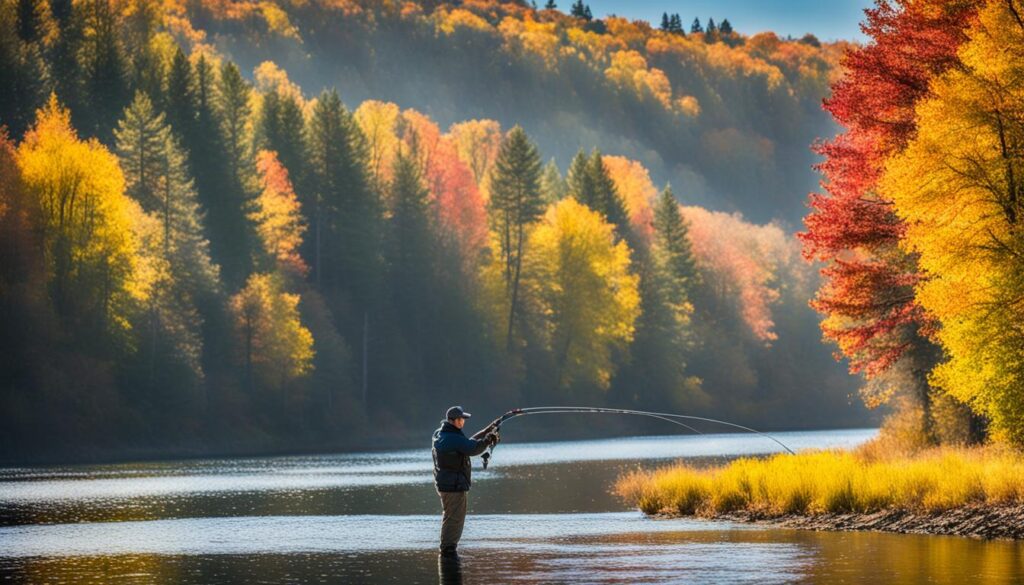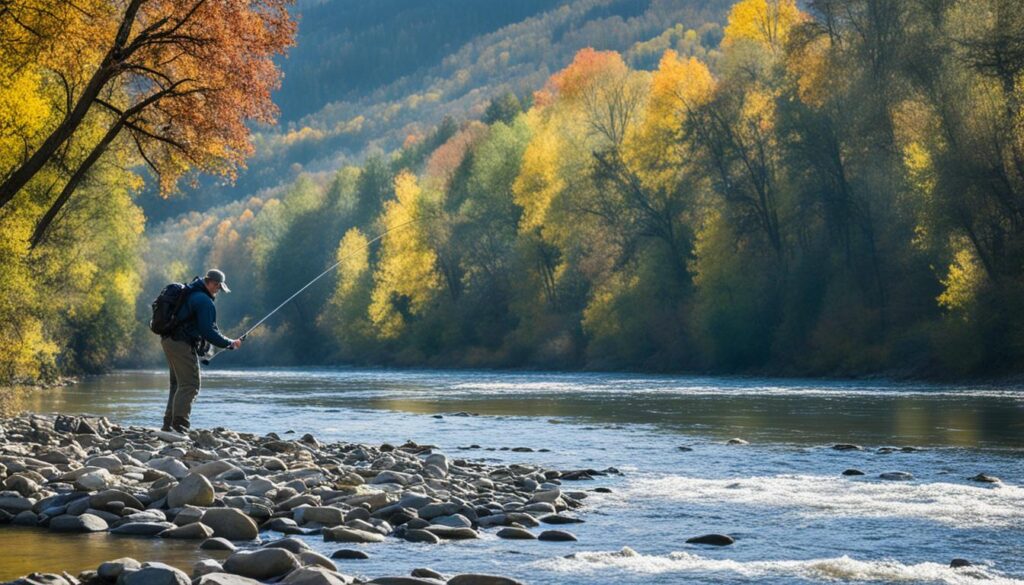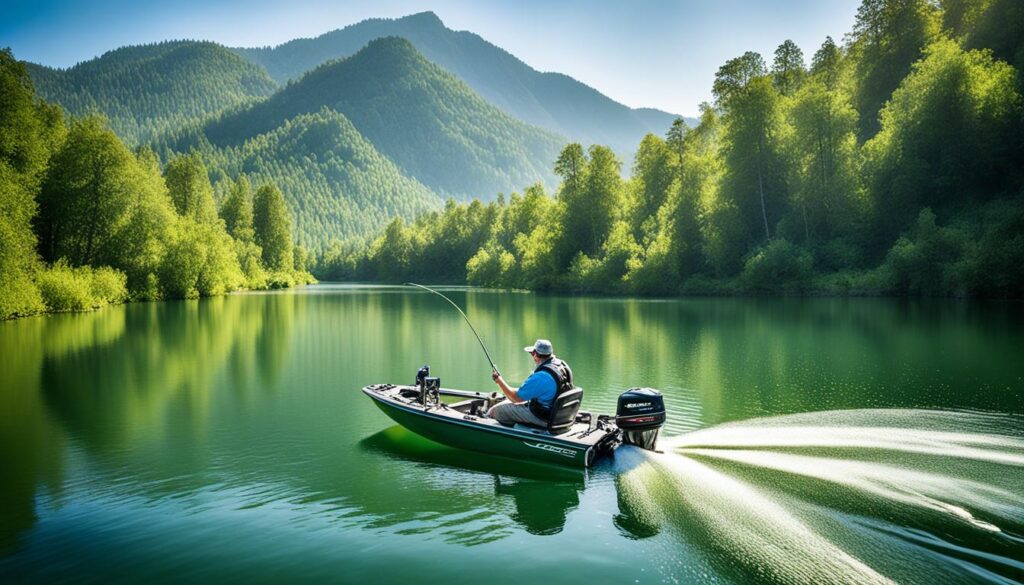Fishing Techniques for Lakes
When fishing on lakes, choosing the right bait is essential based on the type of fish you’re targeting. One reliable option for bass fishing in lakes is using fishing jigs. These versatile lures can mimic various prey and effectively attract largemouth bass.
Key Areas to Target
To increase your chances of success, look for areas heavy with weeds, as largemouth bass and northern pike often lurk in these areas, waiting to ambush their prey. Inlets and outlets can also be productive spots as they tend to be calmer and attract various fish seeking refuge from warmer water.
Fishing Tips
Pay attention to the temperature and movement of the fish. Fish may retreat to deeper parts of the lake as the water temperature rises to find more extraordinary conditions. During dawn and dusk, shallow waters can be particularly productive for fishing when the light is lower. This version maintains your original headers while making the content more concise and reader-friendly.
Fishing Techniques for Rivers
Fishing in rivers requires unique strategies due to constant water movement. Here are some effective techniques for catching largemouth bass in flowing waters:
Live Bait Presentation
Use live bait like minnows, worms, or crawfish for a natural approach. Attach a weight to your line and bounce the bait along the river bottom, mimicking prey movement to entice strikes.
Target Slower Currents
Explore backwaters, side channels, coves, and bays away from the main channel. These calmer areas are ideal for largemouth bass fishing.
Leverage Structures
Focus on water locks and dams, which create excellent fishing spots. These structures control water flow, forming calmer areas where bass often gather.
Tips for Success
- Be patient and observant
- Pay attention to water movement and temperature changes
- Watch for signs of bass activity.
Applying these techniques and tips will boost your chances of landing that trophy largemouth bass in river environments.

Effective Lures for Fall Lake Fishing
When fishing in lakes during the fall, metal reaction baits can be highly effective for catching bass. Here are some tips and techniques to maximize your success:
Flutter Spoons: These lures are excellent for covering large areas of water and triggering feeding responses from bass. The ACME Little Cleo, Blue Fox Moresilda, and Strike King Sexy Spoon are good options for bent spoons that create erratic, enticing movements.
Blade Baits: These lures provide precise presentation and can trigger reaction bites. Classic choices include the Heddon Sonar, Silver Buddy, and Reef Runner Cicada.
Jigging Spoons: Straight spoons like the ACME Kastmaster or Bass Pro Shops XPS Tungsten jigging spoon are effective for vertical jigging over irregular bottoms or along steep ledges.
Fishing Techniques
- Target Deep Vegetation: Focus on deep, lush vegetation beds and isolated weed clumps, which are popular feeding stations for bass in autumn.
- Fan Casting: When using bent spoons or blade baits around grass, fan-cast over the top of vegetation or make short pitches along the outside edge.
- Vertical Jigging: This method is particularly effective for smallmouth bass. Use straight spoons for precision vertical tactics.
- Match the Hatch: Choose lure sizes and colors that mimic the local baitfish bass are feeding on during this time.
- Adapt to Conditions: After cold fronts, switch to slower-moving lures like jigs to entice less active bass.
Additional Tips
- Pay attention to water temperature changes, as bass may move to different depths as the water cools.
- On overcast days, bass may be more aggressive, making it an ideal time for power fishing with reaction baits.
- Don’t overlook topwater lures like walking baits, especially when bass are busting baitfish on the surface in clear water.
By employing these techniques and lures, you can effectively target bass in lakes during the fall season, taking advantage of their increased feeding activity as they prepare for winter.

Best Fishing Gear for Bass Fishing in Lakes and Rivers
Fishing Rods and Reels
- Fishing Gear for Lakes:Rod: Use a medium-heavy to heavy-action rod. This provides the power and control to handle larger fish and cast various lures.
- Reel: Choose a reel with a high gear ratio for quick retrieves. This setup is ideal for targeting largemouth bass in lakes.
- Fishing Gear for Rivers:Rod: Opt for a medium-action rod. This allows for better maneuverability and responsiveness in solid currents.
- Reel: A reel with a medium gear ratio is suitable for river fishing, providing a balance between power and speed to handle aggressive bass.
Bait Choices and Tackle
- Fishing Gear for Lakes:Jigs: Versatile and effective for imitating various prey.
- Weedless Soft Plastics: Creature baits or Texas-rigged worms are great for enticing bass hiding in weed beds.
Fishing Gear for Rivers:
- Live Bait: Minnows or crayfish are highly effective in attracting bass.
- Finesse Plastics: Drop shots or shaky heads mimic natural prey and work well in slower currents.
Comparison of Fishing Gear for Lakes and Rivers
- Lakes:Rod: Medium-heavy to heavy-action
- Reel: High gear ratio
- Bait: Jigs, weedless soft plastics
- Rivers:Rod: Medium-action
- Reel: Medium gear ratio
- Bait: Live bait, finesse plastics
Additional Tips
- For Lakes: Focus on deep vegetation and use fan casting techniques to cover large areas.
- For Rivers: Target slower currents and structures like water locks or dams where bass congregate.
You can significantly improve your chances of landing a big bass by choosing the right fishing rod, reel, and bait for the specific environment. Whether fishing in a serene lake or a dynamic river, the right gear will enhance your fishing adventure.”
Conclusion: Bass Fishing in Lakes and Rivers
Bass fishing offers exciting opportunities in both lakes and rivers, each with its unique challenges and rewards:
Lakes:
- Calm waters are ideal for targeting big fish in weed beds
- Productive spots include inlets and outlets
- Fall fishing: Use metal reaction baits like blade baits and flutter spoons
Rivers:
- Dynamic environment with constant water movement
- Focus on backwaters and slow current areas
- Fall fishing: Finesse plastics like Ned rigs and tubes work well
Key Tips:
- Adapt techniques to the specific environment
- Choose the appropriate gear for your target and technique
- Stock a variety of baits to handle different conditions
Whether you prefer lakes’ serenity or rivers’ thrill, bass fishing provides unforgettable experiences. With the right approach and equipment, you’re set for an exciting day on the water and the chance to land impressive bass!
